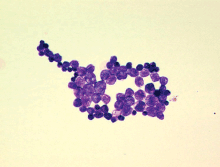Prototheca
| Prototheca | |
|---|---|

| |
| Scientific classification | |
| Clade: | Viridiplantae |
| Division: | Chlorophyta |
| Class: | Trebouxiophyceae |
| Order: | Chlorellales |
| Family: | Chlorellaceae |
| Genus: | Prototheca Krüger, 1894[1] |
| Species[2] | |
Prototheca is a genus of algae in the family Chlorellaceae.[3] While this genus is a member of the green algae, all Prototheca no longer have chloroplasts and therefore their photosynthetic ability. Some species can cause protothecosis in humans and various vertebrates.
Etymology
[edit]From the Greek proto- (first) + thēkē (sheath), Prototheca is a genus of variably shaped spherical cells of achloric algae in the family Chlorellaceae. Wilhelm Krüger, a German expert in plant physiology and sugar production, reported Prototheca microorganisms in 1894, shortly after spending 7 years in Java studying sugarcane. He isolated Prototheca species from the sap of 3 tree species. Krüger named these organisms as P. moriformis and P. zopfii, the second name as a tribute to Friedrich Wilhelm Zopf, a renowned botanist, mycologist, and lichenologist.[4]
Evolution and Taxonomy
[edit]Although Prototheca lack chloroplasts, they were recognized early on as closely related to other Chlorellaceae based on other morphological and physiological traits similar to the group.[5][6] Phylogenetics confirm that Prototheca species are closely related to Chlorella and other genera, although it is not yet clear whether Prototheca is a monophyletic group.[7]
Biology
[edit]With the lack of chloroplasts and photosynthetic ability, Prototheca grow heterotrophically and some exhibit parasitism. Other groups of photosynthetic organisms have undergone similar functional losses in photosynthetic ability and shifted to a parasitic lifestyle, such as in apicomplexans.
Pathogenicity
[edit]Some species in the genus Prototheca are known to cause protothecosis, one of the few researched diseases caused by algae, which are categorized as Algaemia. P. wickerhamii is the main causing agent of protothecosis in humans, and was first identified as such in 1964. P. zopfii is known to cause this disease in cattle and dogs.[citation needed]
Symptoms include: Cutaneous lesions, Olecranon bursitis.
References
[edit]- ^ Krüger, W. (1894). Kurze Charakteristik einiger niedrerer Organismen im Saftfluss der Laubbäume. Hedwigia 33: 241-266, [1].
- ^ Jagielskia T, Bakułaa Z, Gaworb J, Maciszewskic K, Kusberd W, Dyląge M, Nowakowskaf J, Gromadkab R, Karnkowskac A (2019). "The genus Prototheca (Trebouxiophyceae, Chlorophyta) revisited: Implications from molecular taxonomic studies". Algal Research. 43. Bibcode:2019AlgRe..4301639J. doi:10.1016/j.algal.2019.101639.
- ^ See the NCBI webpage on Prototheca. Data extracted from the "NCBI taxonomy resources". National Center for Biotechnology Information. Retrieved 2007-03-19.
- ^ Ollhoff, Rüdiger D.; Sellera, Fábio P.; Pogliani, Fabio C. (November 2021). "Early Release -Etymologia: Prototheca". Emerg Infect Dis. 27 (11): 2891. doi:10.3201/eid2711.211554. PMC 8544978.
Citing public domain text from the CDC.
- ^ Lass-Flörl, Cornelia; Mayr, Astrid (2007-04-01). "Human Protothecosis". Clinical Microbiology Reviews. 20 (2): 230–242. doi:10.1128/CMR.00032-06. ISSN 0893-8512. PMC 1865593. PMID 17428884.
- ^ Ueno, Ryohei; Urano, Naoto; Suzuki, Motofumi (2003-06-01). "Phylogeny of the non-photosynthetic green micro-algal genus Prototheca (Trebouxiophyceae, Chlorophyta) and related taxa inferred from SSU and LSU ribosomal DNA partial sequence data". FEMS Microbiology Letters. 223 (2): 275–280. doi:10.1016/s0378-1097(03)00394-x. ISSN 0378-1097. PMID 12829298.
- ^ Plieger, Tanja; Wolf, Matthias (2022-02-01). "18S and ITS2 rDNA sequence-structure phylogeny of Prototheca (Chlorophyta, Trebouxiophyceae)". Biologia. 77 (2): 569–582. Bibcode:2022Biolg..77..569P. doi:10.1007/s11756-021-00971-y. ISSN 1336-9563.
